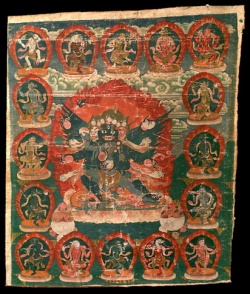Wrathful Deities of the Bardo: Vajra-Heruka and his Consort Vajra-Krodesvari Surrounded by Sixteen Wrathful Goddesses
By Cathleen Cummings
26 May, 1998
Visions of peaceful and wrathful deities appear before the mind of the deceased during the Chonyid Bardo, the second stage of the "in-between" or Bardo state separating death and rebirth. These deities are visions of each individual's own internal buddha-nature which unfold systematically before the deceased in the Bardo, describing complex deity mandalas. The mandala of the forty-two peaceful deities is followed by the fifty-eight wrathful deity mandala. As projections of the consciousness or fundamental awareness of the deceased these figures have no external, physical reality; instead, they serve as guides for the consciousness of the deceased on the path to liberation and enlightenment.
This painting describes Vajra-Heruka who appears in union with his consort Vajra-Krodhesvari on the ninth day of the visions of the Chonyid Bardo. Dark blue in appearance, Vajra-Heruka has three heads, six arms and four legs, and is adorned with the tantric buddha-crown of skulls and a necklace of severed heads. The implements he carries include a vajra, kapala (skull cup) and a battle axe in his right hands, and in his left a ghanta (bell), a kapala and a ploughshare.
Vajra-Heruka is the wrathful manifestation of the Buddha Vajrasattva Aksobhya and his consort Vajra-Krodhesvari is a powerful form of Aksobhya's female counterpart, Buddha Locana. They preside over the eastern quarter of the wrathful deity mandala. The term "heruka" indicates the terrific or powerful form of the deity. Herukas are represented with the wings of the mythical Garuda bird who is the destroyer of serpent demons. The presence of Garuda's wings on a heruka deity symbolizes his power to overcome evil.
In this painting Vajra-Heruka is surrounded by eight Keurima and eight Phra-Men-Ma deities who manifest on the thirteenth day of the Chonyid Bardo. These sixteen goddesses are the wrathful aspects of the eight bodhisattvas and their dakinis, self-generating male-female pairs who accompany the buddhas of the peaceful deity mandala. Terrifying in appearance, the Keurima are wisdom dakinis who signify the eight kinds of awareness. Their function, like that of the male bodhisattvas to which they appear as counterparts, is the enlightenment of these eight awarenesses, but the Keurima's powerful aspect indicates a considerable intensification of this function. The eight Phra-Men-Ma are wrathful animal-headed females who rule over the eight realms of awareness. They are the powerful counterparts to the dakinis of the eight male bodhisattvas of the peaceful deity mandala. The following chart identifies each of these sixteen goddesses as they appear in the painting, and indicates the direction in which each resides, her name, color, and signficant attributes.
Although the herukas and the wrathful dakinis appear in a dangerous form, that danger dissolves if the consciousness of the deceased does not run in fear from these visions but sees them as projections of its own intrinsic buddha-nature. In this way the deceased's consciousness is liberated and enlightenment achieved.
This painting was probably from a set of Five Heruka Deities, that is Buddha-Heruka, Vajra-Heruka, Ratna-Heruka, Padma-Heruka and Karma-Heruka, each surrounded by the same group of Keurima and Phra-Men-Ma dakinis who manifest on the thirteenth day of the Chonyid Bardo.
References:
W. Y. Evans-Wentz, The Tibetan Book of the Dead. 1927. Reprint: Oxford University Press, 1960.
Detlef Ingo Lauf, Secret Doctrines of The Tibetan Books of the Dead. Boulder: Shambhala Publications, 1977.
Robert A. F. Thurman, The Tibetan Book of the Dead. New York: Bantam Books, 1994.
David Germano, "Dying, Death, and Other Opportunities".
